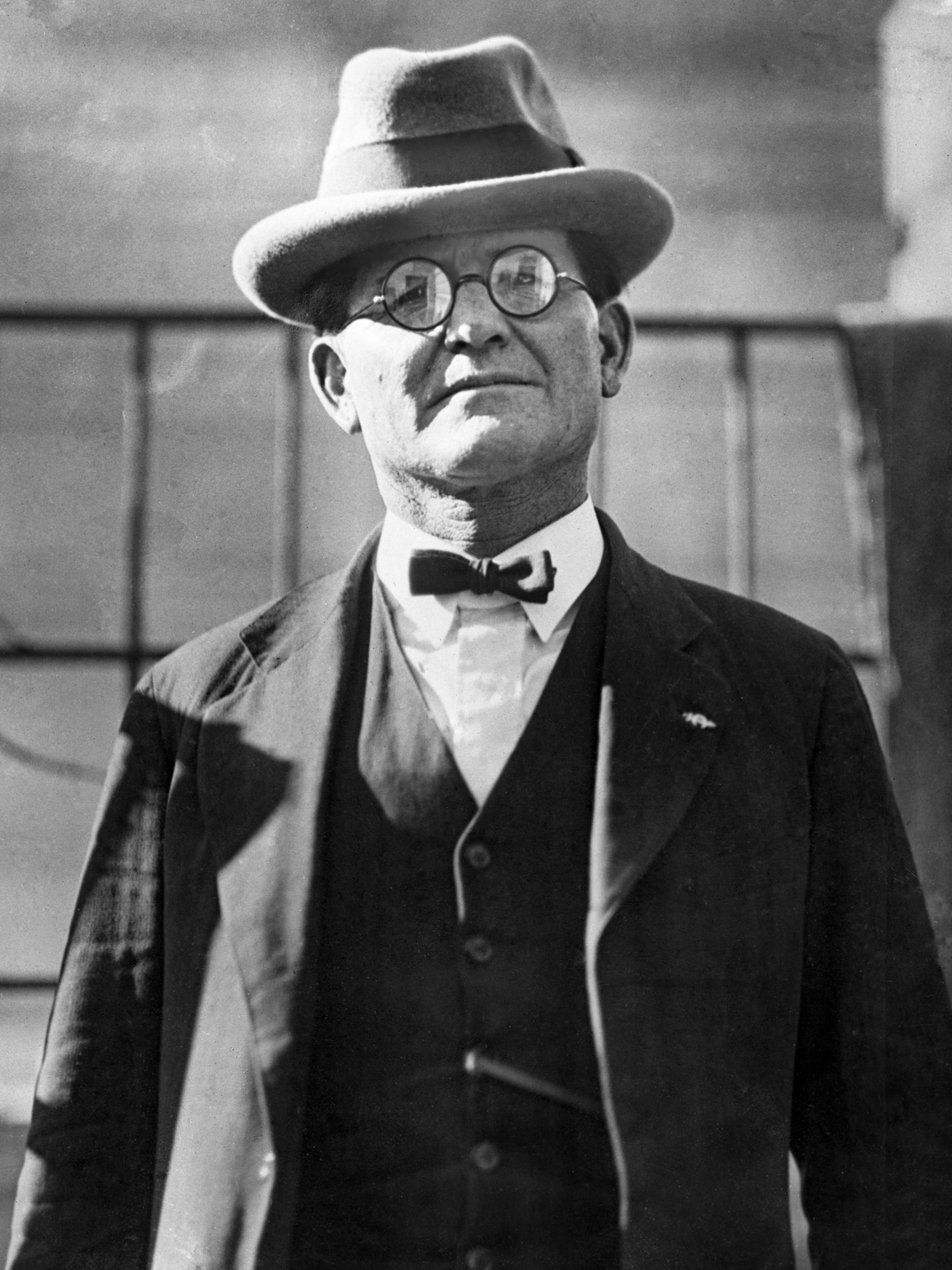Murder. Greed. Conspiracy. What really happened in Osage County?
The suspicious deaths of more than 60 members of Oklahoma’s Osage Nation are the focus of Martin Scorsese’s new film Killers of the Flower Moon.

Poison, jealousy, murder, ambition. Killers of the Flower Moon, Martin Scorsese’s newest film, tells a story seemingly made for Hollywood—the tale of how white settlers used fatal means to seize the wealth of the Osage people of Oklahoma in the early 20th century. But the film, based on David Grann’s bestselling 2017 book of the same name, isn’t all fiction.
Born in very real, misguided federal policies and fueled by the outsized desire of white settlers to profit from Native Americans’ land wealth, local greed resulted in the deaths of at least 60 wealthy Osage people—and possibly many more. Here’s what happened, why some are still left unsolved, and how the crimes set the stage for modern law enforcement in the United States.
The wealth of the Osage
The Osage Nation came into massive wealth after oil was discovered beneath its reservation in the 1890s. Worth about $400 million dollars annually in modern currency by the 1920s, oil transformed the daily lives of the Osage people and turned them into what was then considered the richest nation on Earth.
At the time, prevalent attitudes held that Native Americans were naive, primitive, and in need of white oversight lest they squander their wealth. The government also historically considered Indian tribes to be dependent nations in need of federal protection: promoting laws designed to “protect,” not empower, Native people.

These laws often did not protect Native interests—and instead served as ways for white settlers to seize and retain control over Native people and their ancestral lands. In 1887, for example, the Dawes Act broke tribal lands up and gave them to Native families with tribal claims willing to undergo cultural assimilation. However, the law also sold “excess” land to white settlers, dramatically reducing the amount of land owned by Native nations.
The Osage nation sidestepped this “allotment” system, since it had bought 1.5 million acres of Oklahoma land outright from the federal government when the group was driven out of its ancestral lands in Kansas in 1872. The Osage nation gave all the land to members, each receiving 657 acres. The nation itself held on to the mineral rights of the land, granting each member an inheritable “headright” to the share of the nation’s mineral wealth. As the nation’s oil brought in more and more money, each Osage was entitled to more wealth—drawing the interest, then interference, of non-Osage Oklahomans.
The Osage people’s newfound wealth brought scrutiny to individuals’ money management, and newspaper reports about chauffeured cars, mansions and fancy clothing upset those who thought the Osage should spend their money more wisely. In 1908, in response to an outcry of protest over the Osage Nation’s supposed inability to manage its money, Congress gave county probate courts in Oklahoma jurisdiction over land held by Native Americans who were deemed “minors and incompetents” by a judge. If a person was deemed incompetent, the probate court could appoint a white guardian to oversee their financial affairs—and lease or sell their land.
In 1921, Congress went even further to specify that any person with Osage blood under 21 years of age, in addition to anyone who was half or full Osage, must prove their competency or have a state-court-appointed guardian assume management of their finances. Even the suspicion of irresponsibility was enough for the court to designate a white guardian with the right to disperse an Osage’s money, charge them steep administrative fees—and pocket any funds above a threshold of a $1,000 per quarter. As a result, writes historian Dennis McAuliffe, 600 guardians took $8 million in surplus funds alone with no oversight and no accountability over the course of just three years.


The Osage murders begin
The stage had been set for financial abuse—and soon, murder. Beginning in 1921, a series of mysterious deaths began in Osage County.
In May 1921, the bodies of Anna Brown and her cousin Charles Whitehorn were discovered on the same day in different parts of the county. Two months later, Brown’s mother Lizzie Kyle, who had inherited headrights, was killed by poisoning. Then, Lizzie’s nephew was killed in February 1923—and on March 10, Lizzie’s daughter, her son-in-law, and a domestic worker died in a mysterious explosion at their home. The deaths sparked panic throughout Osage County and became known as a “reign of terror.” Meanwhile, the massive wealth of the Kyle family was inherited by the only survivors—Mollie Kyle, a full-blooded Osage who was Lizzie’s last remaining daughter, and her white husband Ernest Burkhardt.
The Kyles weren’t the only Osage people who died around this time, all under suspicious circumstances that included suspected poisonings, supposed suicides, and even being thrown off a train. Between 1921 and 1925, at least 60 Osage people were murdered or disappeared. All possessed wealth due to their headrights—and the Osage Tribal Council suspected that a prominent local white cattleman, William K. Hale, might be to blame.
Hale, originally from Texas, was known for his exploitative financial dealings with Osage people, and he was of outsized influence in Osage County. He owned or partially controlled the bank, the local general store, the funeral home, and even served as a reserve sheriff. Hale’s nephew, Burkhardt, was married to Mollie Kyle, who had now inherited her family members’ millions. Though the murders continued, local investigations and law enforcement efforts to solve the murders failed.
The Osage Tribal Council turned to the federal government for help solving the mystery of the murders. In response, the Bureau of Investigation, now known as the Federal Bureau of Investigation, began an undercover investigation in the area.
As the investigation began teasing out Hale’s possible connection to the killings, more murders occurred. When Mollie Kyle confessed to her priest that she thought she might be being poisoned, investigators cracked the case. Hale, it turned out, had pressured his nephew to marry Kyle, then engaged contract killers to murder her entire family. Under pressure from his uncle, Burkhardt had been giving his wife poison-laced whiskey to drink.
After a variety of state and federal trials that mesmerized the nation with their dramatic proceedings—and the murders of several potential witnesses—Hale and two accomplices were sentenced to life in prison. But many of the Osage murders remain unsolved mysteries.
“Killers of the Flower Moon”
Nor did the saga of the Osage Nation’s wealth end with the killers’ convictions. In 1925, Congress passed a law prohibiting non-Osage people from inheriting headrights owned by people with Osage or other Native American ancestry. But complaints about the federal government’s dealings with the Osage Nation’s assets continued. In 2011, after decades of legal tussling, the U.S. government finally gave the Osage Nation a $380 million settlement and agreed to a variety of measures designed to better manage the Osage Nation’s assets.
Today, the Osage Nation murders are largely thought to have been the case that helped birth the FBI and modern law enforcement, which relies on extensive investigations, undercover operations, and the use of informants to crack complex criminal cases. Though the murders began over a century ago, they still echo in the lives and finances of the Osage people.
Today, the Osage Nation notes on its website, approximately 26 percent of Osage headrights remain in non-Osage hands and can be passed on to non-Osage entities at will. Though the Killers of the Flower Moon looks at long-past events, the Nation writes, “We are not relics. The Osage Nation is thriving on our Reservation in Northeast Oklahoma - a people of strength, hope, and passion, honoring the stories of the past and building the world of the future.”
Related Topics
You May Also Like
Go Further
Animals
- We finally know how cockroaches conquered the worldWe finally know how cockroaches conquered the world
- Move over, honeybees—America's 4,000 native bees need a day in the sunMove over, honeybees—America's 4,000 native bees need a day in the sun
- Surveillance Safari: Crowdsourcing an anti-poaching movement in South Africa
- Paid Content
Surveillance Safari: Crowdsourcing an anti-poaching movement in South Africa - Fireflies are nature’s light show at this West Virginia state parkFireflies are nature’s light show at this West Virginia state park
- These are the weird reasons octopuses change shape and colorThese are the weird reasons octopuses change shape and color
- Why young scientists want you to care about 'scary' speciesWhy young scientists want you to care about 'scary' species
Environment
- These images will help you see coral reefs in a whole new wayThese images will help you see coral reefs in a whole new way
- What rising temperatures in the Gulf of Maine mean for wildlifeWhat rising temperatures in the Gulf of Maine mean for wildlife
- He’s called ‘omacha,’ a dolphin that transforms into a man. Why?He’s called ‘omacha,’ a dolphin that transforms into a man. Why?
- The northernmost flower living at the top of the worldThe northernmost flower living at the top of the world
- This beautiful floating flower is wreaking havoc on NigeriaThis beautiful floating flower is wreaking havoc on Nigeria
History & Culture
- Scientists find evidence of ancient waterway beside Egypt’s pyramidsScientists find evidence of ancient waterway beside Egypt’s pyramids
- This thriving society vanished into thin air. What happened?This thriving society vanished into thin air. What happened?
Science
- Why pickleball is so good for your body and your mindWhy pickleball is so good for your body and your mind
- Extreme heat can be deadly – here’s how to know if you’re at riskExtreme heat can be deadly – here’s how to know if you’re at risk
- Why dopamine drives you to do hard things—even without a rewardWhy dopamine drives you to do hard things—even without a reward
- What will astronauts use to drive across the Moon?What will astronauts use to drive across the Moon?
- Oral contraceptives may help lower the risk of sports injuriesOral contraceptives may help lower the risk of sports injuries
- How stressed are you? Answer these 10 questions to find out.
- Science
How stressed are you? Answer these 10 questions to find out.
Travel
- The ‘Yosemite of South America’ is an adventure playgroundThe ‘Yosemite of South America’ is an adventure playground
- These farmers make it possible for hikers to access Alpine trailsThese farmers make it possible for hikers to access Alpine trails
- A guide to Philadelphia, the US city stepping out of NYC's shadowA guide to Philadelphia, the US city stepping out of NYC's shadow
- How to make perfect pierogi, Poland's famous dumplingsHow to make perfect pierogi, Poland's famous dumplings
- The best long-distance Alpine hike you've never heard ofThe best long-distance Alpine hike you've never heard of







